The Earth's relief
Our planet is made up of land and water. The land is separated into six large landmasses known as continents. The continents are Asia, America, Africa, Antarctica, Europe and Oceania. The continents are not flat. They have different kinds of relief, including plains, plateaus, mountain ranges, valleys and basins. Around the continents are oceans. The action of the water on the land has changed the shape of coastal areas. [...]
Esta secuencia contiene:
-
13 actividades
-
92 recursos
-
Idioma:
- Inglés
-
Formato:
Interactivo
Secuencia didáctica
-
Didactic objectives Identify the layers that form the structure of the Earth. Understand the theory of continental drift and analyse a map of the tectonic plates. Identify the internal and external forces in the formation of relief. [...]
-
1. The outer layer of the Earth The Earth is made up of three concentric layers of different thickness: Core: the Earth’s deepest layer, which itself is made up of two separate layers. [...]
-
Our planet is made up of land and water. The land is separated into six large landmasses known as continents. The continents are Asia, America, Africa, Antarctica, Europe and Oceania. The continents are not flat. [...]
-
1.1. The structure of the Earth The Earth is a huge sphere. It can be divided into three large sections: The deepest part is the core. It is 15% of the planet's total volume. The core is part solid and part liquid. [...]
-
2.1. Internal forces Below the surface of the Earth, gases and compressed materials put pressure on the crust. They can deform it or make it crack. These internal forces are what cause earthquakes and volcanoes. [...]
-
3.1. External forces Relief is not only the result of movements inside the Earth. External forces, such as the effect of water or wind, can also change the shape of the planet's surface. [...]
-
The combined action of internal and external forces shapes the surface of the Earth. The result is different kinds of relief. Mountains are a good example of a kind of relief that can condition human activity. [...]
-
4.1. The division of the world into continents Continents are enormous landmasses separated by oceans. Africa Africa is separated from Europe by the Mediterranean Sea, and from Asia by the Red Sea. [...]
-
5.1. The relief of the continents The surface of the continents is not smooth or uniform. The relief includes mountains, plains, plateaus and valleys. Islands in the oceans and seas can be part of the underwater relief. [...]
-
6.1. The european continent Europe is a small continent. It measures 5000 km from east to west and 4000 km from north to south. It can also be considered as a peninsula of the larger Eurasian continent. [...]
-
7.1. The relief of the Iberian Peninsula The Iberian Peninsula is in the south-west of Europe. Its limits are the Bay of Biscay, the Atlantic Ocean and the Mediterranean Sea. The Meseta is the central feature of relief on the peninsula. [...]
-
Our planet is made up of land and water. The land is separated into six large landmasses known as continents. The continents are Asia, America, Africa, Antarctica, Europe and Oceania. The continents are not flat. [...]
-
Our planet is made up of land and water. The land is separated into six large landmasses known as continents. The continents are Asia, America, Africa, Antarctica, Europe and Oceania. The continents are not flat. [...]
Cursos y asignaturas
-
12 años:
- Geografía
- Historia
-
13 años:
- Historia
- Geografía
-
Aún no hay comentarios, ¡comparte tu opinión! Inicia sesión o Únete a Tiching para poder comentar
La licencia digital es una autorización que permite utilizar un recurso digital de acuerdo con las condiciones legales de dicho recurso. El código que recibas una vez la hayas comprado te permitirá acceder al recurso educativo digital elegido.
Puedes consultar más información en nuestra página de ayuda.




























¿Dónde quieres compartirlo?
¿Quieres copiar el enlace?